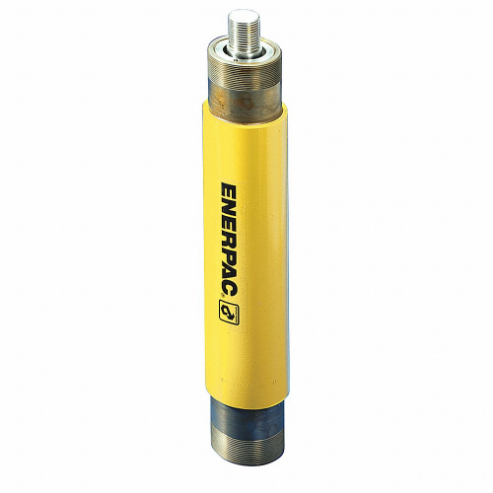Enerpac RD910 hydraulic cylinder is ideal for use in repeated cycles of lifting and supporting objects in the production line. It is also used with fixtures to crimp, punch and press. This hydraulic cylinder can be used independently for lifting heavy objects.
Working Mechanism:
- Enerpac RD910 double acting hydraulic cylinder consists of a cylindrical barrel, piston assembly, piston rods, seals and hydraulic connections.
- Hydraulic fluid is supplied under pressure to both the cap-end and rod-end ports of the cylinder.
- When fluid is supplied to the cap end, it pushes the piston assembly, extending the piston rod and generating a pushing force.
- Conversely, when fluid is supplied to the rod end, it pulls the piston assembly, extending the rod and generating a pulling force.
Features:
- Enerpac RD910 double acting hydraulic cylinder features steel construction with baked enamel finish that offers increased corrosion resistance and rigidity.
- This hydraulic cylinder has double-acting operation which generates force in both up and down directions for adaptability.
- It is integrated with a plunger wiper to prevent contaminants from entering inside the cylinder and enhance service life.
- This Enerpac RD910 double acting hydraulic cylinder can handle operating pressures up to 10000 psi.
Compatible Accessories:
- Enerpac AD171 Foot Mounting: It is designed for use with this Enerpac cylinder, providing a secure and stable base for the cylinder, allowing for easier and more efficient operation.
- Enerpac AD172 Flange Adapter: It is suitable for use with this Enerpac RCH-206 cylinder, allowing easy and secure connection of the cylinder to a flange or mounting surface, enhancing the versatility and functionality of the hydraulic system.
- Enerpac AD173 Retainer Nut: It is designed for secure and stable assembly of this Enerpac cylinder, ensuring reliable operation during hydraulic applications.
- Enerpac AD151 Clevis Eye: It provides a reliable connection point for attaching the cylinder to various load-bearing components, enabling efficient and effective hydraulic operations.
Frequently Asked Questions:
Q. What will happen if the air is trapped in a hydraulic system?
A. When air contaminates the hydraulic fluid cavitation, aeration or foaming can happen that degrades the hydraulic fluid, thereby resulting in component damage or a loss of lubrication.
Q. What causes side loading in hydraulic cylinders?
A. Side loads occur when unequal pressure is forced on the centre of the piston rod.
Q. What causes a hydraulic cylinder to lose pressure?
A. A drift condition causes hydraulic cylinders to lose pressure when the drift is caused by an internal leak (in the cylinder across the piston) or an external leak has occurred.
 Change Country
Change Country

